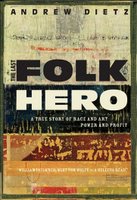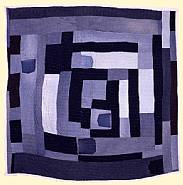 "Black vernacular art," says Bill Arnett in his inimitably exaggerated style, "is the most important cultural phenomenon of our time. This is like the Italian Renaissance in its scope, breadth, and depth. It's just that the people are the wrong color."
"Black vernacular art," says Bill Arnett in his inimitably exaggerated style, "is the most important cultural phenomenon of our time. This is like the Italian Renaissance in its scope, breadth, and depth. It's just that the people are the wrong color." This quote from Andrew Dietz's book The Last Folk Hero begins to capture both the audacity and passion of Arnett, one of contemporary folk art's biggest benefactors and, according to some, its greatest villain. Accused of exploiting self-taught artists like Lonnie Holley, Thornton Dial, and the famed quilters at Gee's Bend through exclusive sales deals, Arnett is also arguably the top promoter of these artists. But after finishing Dietz's book, I'm still unsure who the last folk hero is. Arnett? At times he's presented as an unlikable and pompous boob, as Dietz chronicles him unheroically compiling enemies' lists, stepping on the toes of those in southern museums who can help his cause, and waxing paranoiac about those who are out to get him. At others, he's a charming, impassioned guy with genuine concern for these under-recognized artists.
More likely, the heroes are the artists who use housepaint or wire, tree roots or scraps of fabric to create works of art every bit as powerful as those of their schooled contemporaries: Former Whitney director Max Anderson says, "Lonnie Holley and Thornton Dial are the equals of any artists in the United States," and The New York Times' Michael Kimmelman called the Gee's Bend quilts "some of the most miraculous works of modern art America has produced. Imagine Matisse and Klee (if you think I'm wildly exaggerating, see the show) arising not from rarefied Europe, but from the caramel soil of the rural South in the form of women, descendants of slaves when Gee's Bend was a plantation." (Compare Linda Pettway's quilt, below, with Hans Arp's 1916-17 collage Untitled (Collage with Squares Arranged According to the Laws of Chance) and you start to see where Kimmelman's coming from.)
 From these tenaciously unconventional artists to Arnett's testy clashes with southern collectors to Dietz's own experiences, The Last Folk Hero is truly an "outsider" journey. At one point Dietz quotes Peter Marzio, longtime director of the Museum of Fine Arts, Houston, who revealed that even on an institutional level, this art is far from accepted. Disappointed that no museums signed on early to tour the quilt show, he said:
From these tenaciously unconventional artists to Arnett's testy clashes with southern collectors to Dietz's own experiences, The Last Folk Hero is truly an "outsider" journey. At one point Dietz quotes Peter Marzio, longtime director of the Museum of Fine Arts, Houston, who revealed that even on an institutional level, this art is far from accepted. Disappointed that no museums signed on early to tour the quilt show, he said:The other museum directors just didn't think it was art. This kind of art is threatening to the academy, the traditional art infrastructure. It throws up to them that the creative world can take many routes--outside of the main channels they control. The people of my generation, who were so antiestablishment, are more reactive and defensive culturally now than the nineteenth-century academy was to the advent of modern art.As I've written before, self-taught and "outsider" art offers us not only an alternative to the fickle machinations and trends of the art world, but also to mainstream consumer culture, where creative autonomy is often packaged as hip consumption--our creativity is demonstrated by our buying choices instead of how true we are to our own visions. These artists, in their eccentric and unswerving dedication to their own expressions, offer a compelling model of true American independence.
 Maybe that's why I'm writing so much about The Last Folk Hero. Dietz's project has that kind of autonomous spirit. Written in spare time while running a business and raising two children, he ended up self-publishing the book. He founded Ellis Lane Press, a moniker that combines his daughters' middle names, "to remind them that we cannot wait to be annointed as valid or creative by unseen, random others but rather we need to take the responsibility to validate ourselves and put something positive into this world."
Maybe that's why I'm writing so much about The Last Folk Hero. Dietz's project has that kind of autonomous spirit. Written in spare time while running a business and raising two children, he ended up self-publishing the book. He founded Ellis Lane Press, a moniker that combines his daughters' middle names, "to remind them that we cannot wait to be annointed as valid or creative by unseen, random others but rather we need to take the responsibility to validate ourselves and put something positive into this world." But there's another reason: no one would publish the book.
"I completely lost patience with the big publishers who all said the same thing about the early proposal: 'We love the story; great characters; terrific writing; WE would love to read the book...but...we don't publish books about art because they don't sell,'" he wrote in an email. "Well, I thought that was like saying that Midnight in the Garden of Good and Evil was just a story about antiques in Savannah or Seabiscuit was just about some horses."
Summing it all up, then, is a great quote by George Bernard Shaw that Dietz uses in the book. It's as fitting for Pettway or Dial, Arnett or Dietz, or, hell, any of us who have a vision. Writes Dietz:
"All progress is the result of the unreasonable man." Of course, when I asked Bill Arnett what he thought about that he answered, "Shaw wasn't talking about ME, I never met the man!"Artwork (top to bottom): Thornton Dial's Ground Zero: Nighttime All Over the World (2002); Linda Pettway's Blocks and Strips, 2003
Paul,
ReplyDeleteGreat post! I think I'll pick up a copy of the book at some point.
But I'd like to point out that while outsider artists themselves may be "a compelling model of real American independence," the gatekeepers of the outsider art establishment *can be* just as inaccessible as their peers in the fine art establishment… I once almost got into a fist fight with a member of Intuit at a show because she insisted I couldn't possibly be self taught. Apparently, I was "too articulate." Well, hell, I was a poet for 15 years before I started making art but most of that was self taught too…
In the long run, I ended having to just *further* my education on my own until *no one* could tell I hadn't had training. Now I earn a full-time living with art.
I guess it all boils down to the fact that people are people. They do what they do regardless of labels… maybe it's as unfair that I should point her out as an example of her tribe, as it was for her to refuse to believe I had no formal art training. I dunno. But in the long run, I make better money now, so maybe she did me a favor.
I've just always been a bit uncomfortable with the feeling that many of the outsider superstars owe their fame to people that bought a ton of work while it was still cheap and then brought the price way up through hardcore promotion. It often seemed that for some, the real definition of an outsider artist was "someone unschooled enough in business that I can really rake it in if I "discover" them. That always bugged me, and I'm not often one to complain about such things. The artwork is no better or worse than art from schools (well, I often like it better, but that's just taste) but the system isn't radically different.
Thanks, John. You're right about exploitation. I've written about a few self-taught artists over the years, and I've had some weird run-ins with the handlers who stand to profit from them. (One gallery owner told me one artist "was like a caged animal" when he first met him, not realizing that caged animal--who happened to be African American--had been my friend for years and my experiences didn't jive with this mythologized and racist depiction. Another said she "discovered" an artist; when I asked how, she said the artist was selling his work in a parking lot... Sounds like he discovered himself.)
ReplyDeleteIt's tricky writing about these topics. Some of these artists are poor, many are black, some have mental illness to deal with, others have foregone art school and make art independently, and lots of people are angling to cash in. I tend to put quotes around "outsider" because the industry of art pulls artists who may create work removed (physically, aesthetically, etc.) from many of the influences trained artists respond to, but the gallery representation tends to be fully inside.
I get review copies of books from publishers, and Dietz' is the first I've reviewed, mainly because he wrote about these topics in a fair way, treating the artists as people, not as shamans or weirdos, and he seems to understand how race and the market can complicate everything.
Paul,
ReplyDeleteIt's all good, thanks for the reply. "Outsider exploitation" is just one of those triggers for me, based on my own experiences (many of which mirror your own). I've been following your blog for about a year, so I know you get it. My comment was aimed more at readers than yourself.
It *is* a really tricky thing to write about and I think you did a pretty bang-up job. There's a lot of BS and hyperbole in all the art markets… but sometimes in the outsider market it just gets over the top (caged animal indeed!).
Anyway, eventually I'll try to pick up a copy of Dietz' book. It does sound like a good read. Thanks for calling it to my atttention!